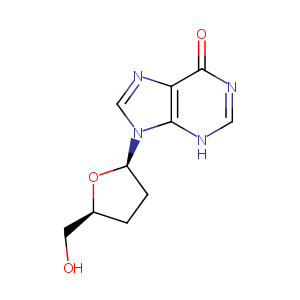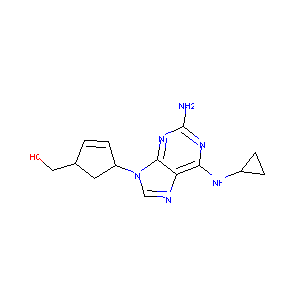| 1 |
ClinicalTrials.gov (NCT00338390) Study to Evaluate Changes in CD4 on Replacing TDF With ABC or DDI+TDF With ABC+3TC
|
| 2 |
URL: http://www.guidetopharmacology.org Nucleic Acids Res. 2015 Oct 12. pii: gkv1037. The IUPHAR/BPS Guide to PHARMACOLOGY in 2016: towards curated quantitative interactions between 1300 protein targets and 6000 ligands. (Ligand id: 4833).
|
| 3 |
Abacavir (marketed as Ziagen) and Abacavir-containing Medications. FDA. 2008.
|
| 4 |
The effect of individual antiretroviral drugs on body composition in HIV-infected persons initiating highly active antiretroviral therapy. J Acquir Immune Defic Syndr. 2009 Jul 1;51(3):298-304.
|
| 5 |
Clinical Nephrotoxins: Renal Injury from Drugs and Chemicals.
|
| 6 |
ADReCS-Target: target profiles for aiding drug safety research and application. Nucleic Acids Res. 2018 Jan 4;46(D1):D911-D917. doi: 10.1093/nar/gkx899.
|
| 7 |
In vitro cytotoxicity and mitochondrial toxicity of tenofovir alone and in combination with other antiretrovirals in human renal proximal tubule cells. Antimicrob Agents Chemother. 2006 Nov;50(11):3824-32. doi: 10.1128/AAC.00437-06. Epub 2006 Aug 28.
|
| 8 |
Binding of anti-HIV drugs to human serum albumin. IUBMB Life. 2004 Oct;56(10):609-14. doi: 10.1080/15216540400016286.
|
| 9 |
An in vitro coculture system of human peripheral blood mononuclear cells with hepatocellular carcinoma-derived cells for predicting drug-induced liver injury. Arch Toxicol. 2021 Jan;95(1):149-168. doi: 10.1007/s00204-020-02882-4. Epub 2020 Aug 20.
|
| 10 |
Facilitated mitochondrial import of antiviral and anticancer nucleoside drugs by human equilibrative nucleoside transporter-3. Am J Physiol Gastrointest Liver Physiol. 2009 Apr;296(4):G910-22. doi: 10.1152/ajpgi.90672.2008. Epub 2009 Jan 22.
|
| 11 |
Exposure-based assessment of chemical teratogenicity using morphogenetic aggregates of human embryonic stem cells. Reprod Toxicol. 2020 Jan;91:74-91. doi: 10.1016/j.reprotox.2019.10.004. Epub 2019 Nov 8.
|
| 12 |
Mitochondrial proliferation, DNA depletion and adipocyte differentiation in subcutaneous adipose tissue of HIV-positive HAART recipients. Antivir Ther. 2003 Aug;8(4):323-31.
|
| 13 |
Quadruple nucleos(t)ide reverse transcriptase inhibitors-only regimen of tenofovir plus zidovudine/lamivudine/abacavir in heavily pre-treated HIV-1 infected patients: salvage therapy or backbone only Curr HIV Res. 2009 May;7(3):320-6.
|
| 14 |
The transport of anti-HIV drugs across blood-CNS interfaces: summary of current knowledge and recommendations for further research. Antiviral Res. 2009 May;82(2):A99-109.
|
| 15 |
QSAR analysis and molecular modeling of ABCG2-specific inhibitors. Adv Drug Deliv Rev. 2009 Jan 31;61(1):34-46.
|
| 16 |
Human intestinal transporter database: QSAR modeling and virtual profiling of drug uptake, efflux and interactions. Pharm Res. 2013 Apr;30(4):996-1007.
|
| 17 |
A review of the pharmacokinetics of abacavir. Clin Pharmacokinet. 2008;47(6):351-71.
|
| 18 |
Product characteristics of Triumeq.
|
| 19 |
Genetic variations in HLA-B region and hypersensitivity reactions to abacavir. Lancet. 2002 Mar 30;359(9312):1121-2. doi: 10.1016/S0140-6736(02)08158-8.
|
| 20 |
Changes in biomarkers of cardiovascular risk after a switch to abacavir in HIV-1-infected individuals receiving combination antiretroviral therapy. HIV Med. 2009 Nov;10(10):627-33.
|
| 21 |
The antiretroviral nucleoside analogue Abacavir reduces cell growth and promotes differentiation of human medulloblastoma cells. Int J Cancer. 2009 Jul 1;125(1):235-43. doi: 10.1002/ijc.24331.
|
| 22 |
Association of CYP1A1 and CYP1B1 inhibition in in vitro assays with drug-induced liver injury. J Toxicol Sci. 2021;46(4):167-176. doi: 10.2131/jts.46.167.
|
| 23 |
Harvesting candidate genes responsible for serious adverse drug reactions from a chemical-protein interactome. PLoS Comput Biol. 2009 Jul;5(7):e1000441. doi: 10.1371/journal.pcbi.1000441. Epub 2009 Jul 24.
|
| 24 |
Intracellular cytokines may model immunoregulation of abacavir hypersensitivity in HIV-infected subjects. J Allergy Clin Immunol. 2005 May;115(5):1081-7. doi: 10.1016/j.jaci.2004.12.1140.
|
| 25 |
The HCP5 single-nucleotide polymorphism: a simple screening tool for prediction of hypersensitivity reaction to abacavir. J Infect Dis. 2008 Sep 15;198(6):864-7. doi: 10.1086/591184.
|
|
|
|
|
|
|


